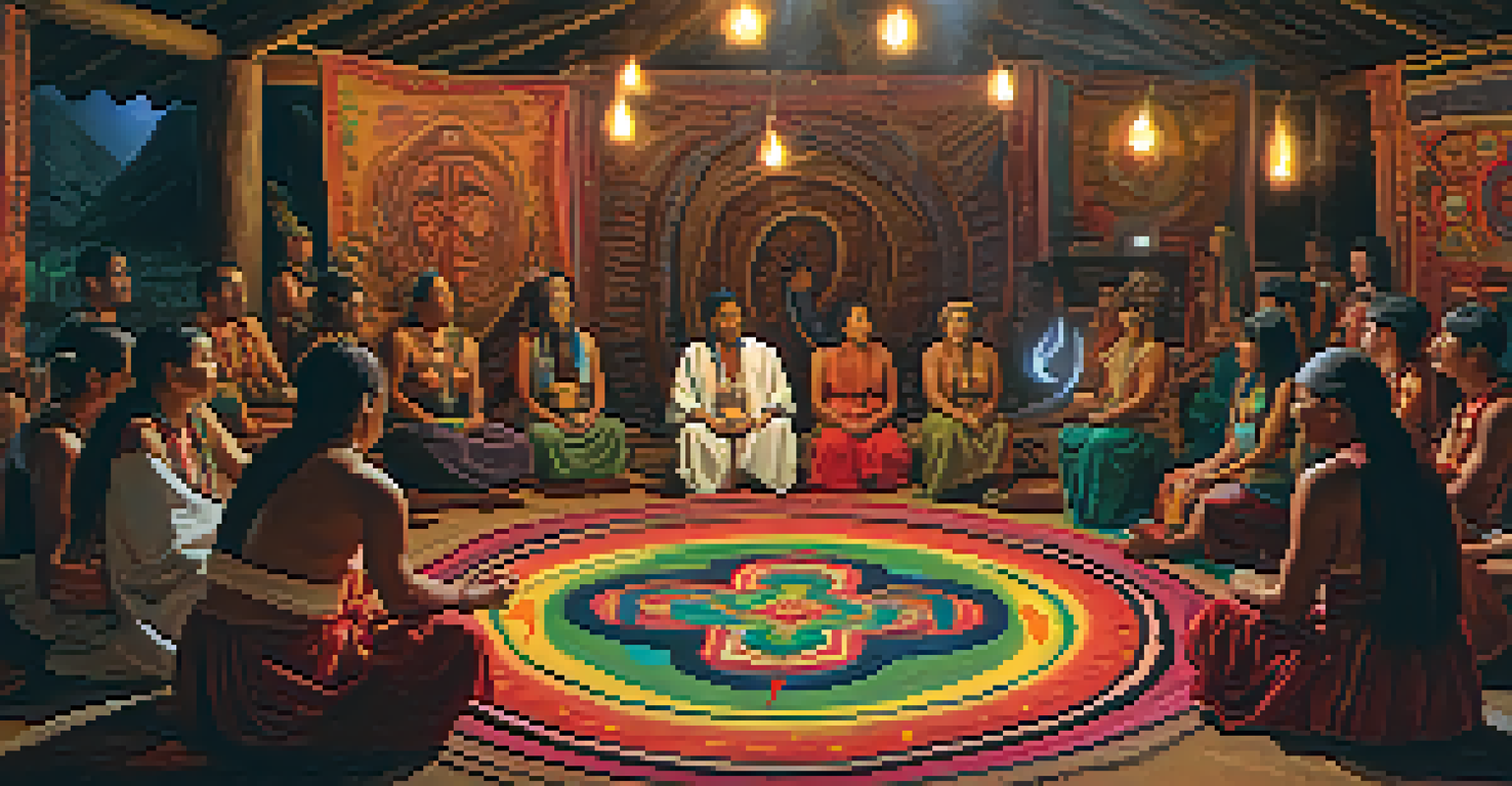The Ayahuasca Ceremony: Steps and Practices Explained

What is Ayahuasca and Its Cultural Significance?
Ayahuasca is a powerful plant-based brew originating from the Amazon rainforest, traditionally used by Indigenous peoples for spiritual and healing purposes. It combines two main ingredients: the Banisteriopsis caapi vine and the Psychotria viridis leaf, creating a potent concoction that induces altered states of consciousness. The cultural significance of Ayahuasca cannot be overstated, as it is often viewed as a sacred medicine that facilitates deep introspection and connection with nature.
Ayahuasca is not just a drink; it is a sacred medicine that connects us to our true selves and the world around us.
For many, participating in an Ayahuasca ceremony is seen as a rite of passage, a way to confront personal challenges, or seek guidance from a higher power. The ceremony is guided by a shaman or experienced facilitator, who plays an essential role in creating a safe and supportive environment. This cultural context helps participants understand and respect the profound nature of the experience they are about to embark on.
In modern times, Ayahuasca has gained popularity beyond its Indigenous roots, attracting individuals from around the globe seeking personal growth and healing. However, it's essential to approach this practice with cultural sensitivity and awareness, recognizing the traditions and beliefs that have been passed down through generations.
Preparing for the Ayahuasca Ceremony: Dos and Don'ts
Preparation for an Ayahuasca ceremony involves both physical and mental aspects. Participants are often advised to follow a specific dieta, which includes dietary restrictions such as avoiding alcohol, processed foods, and certain medications. This preparation helps to cleanse the body and mind, making the Ayahuasca experience more profound and meaningful.

Mental preparation is equally important. Engaging in self-reflection and setting intentions for the ceremony can greatly enhance the experience. Think about what you hope to gain from the journey, whether it's healing, clarity, or spiritual connection. This intention-setting acts as a guiding force during the ceremony, helping participants navigate their experiences.
Understanding Ayahuasca's Roots
Ayahuasca is a sacred brew from the Amazon, used for spiritual healing and introspection by Indigenous peoples.
Lastly, it’s crucial to choose a reputable retreat or facilitator. Look for reviews, testimonials, and ensure that the shaman has a deep understanding of the ceremony and its practices. A safe environment is paramount for a transformative experience, so trust your instincts when selecting where to participate.
The Setting: What to Expect During the Ceremony
The setting of an Ayahuasca ceremony plays a vital role in shaping the experience. Typically held in a tranquil and natural environment, the atmosphere is designed to promote relaxation and introspection. Many ceremonies take place in a dimly lit space adorned with meaningful symbols, creating a sacred space that encourages participants to delve deep into their consciousness.
The journey of Ayahuasca is a journey of the heart, where we confront our fears and embrace our healing.
Upon arrival, participants are often welcomed with a calming ritual, which may include songs or prayers led by the shaman. This initial gathering helps to establish a sense of community and connection among attendees, easing any feelings of anxiety or apprehension. Each participant is encouraged to share their intentions, fostering an environment of support and openness.
As the ceremony begins, participants consume the Ayahuasca brew, typically followed by a period of silence to allow the medicine to take effect. During this time, the shaman may guide the ceremony with songs known as icaros, which are believed to enhance the healing experience. The combination of setting, intention, and guidance creates a unique and profound atmosphere for self-discovery.
The Journey: Experiences and Emotions During Ayahuasca
The journey during an Ayahuasca ceremony can vary significantly from person to person, as each individual's experience is shaped by their intentions, emotional state, and personal history. Commonly, participants report experiencing vivid visuals, emotional releases, and profound insights that can lead to a deeper understanding of themselves and their place in the world. These experiences can be both beautiful and challenging, often reflecting the internal struggles one may face.
It's not uncommon for participants to confront difficult emotions or memories during the ceremony, a process that can be cathartic and healing. This confrontation helps individuals address unresolved issues, leading to a sense of relief and empowerment. However, it’s essential to approach these emotions with an open heart and mind, recognizing that discomfort can often lead to growth.
Importance of Ceremony Preparation
Proper preparation, including dietary restrictions and intention-setting, enhances the Ayahuasca experience.
Additionally, many participants describe feelings of interconnectedness with nature and the universe, experiencing a sense of unity that transcends the physical realm. This spiritual connection can foster a greater appreciation for life, prompting individuals to reflect on their actions and relationships. Overall, the journey can be transformative, leaving lasting impressions long after the ceremony concludes.
Integration: Making Sense of Your Ayahuasca Experience
After the ceremony, integration is a crucial step in processing the insights gained during the experience. This phase involves reflecting on the journey and incorporating its lessons into daily life. Participants often find it helpful to journal their thoughts, allowing them to articulate their emotions and realizations in a tangible form.
Engaging in conversations with fellow participants or facilitators can also aid in the integration process. Sharing experiences can foster a sense of community and support, helping individuals feel less isolated in their journey. Many people find that discussing their insights with others can lead to new perspectives and deeper understanding.
Additionally, seeking professional support, such as therapy or counseling, can help individuals navigate any lingering emotions or challenges that arise post-ceremony. Integration is not just about understanding the experience but actively applying its lessons to foster personal growth and healing in everyday life.
Potential Risks and Considerations of Ayahuasca Use
While many people report positive experiences with Ayahuasca, it’s important to acknowledge potential risks associated with its use. The brew can provoke intense emotional and psychological reactions, which may be overwhelming for some individuals. It's crucial to approach Ayahuasca with caution, particularly for those with a history of mental health issues, as it can exacerbate underlying conditions.
Another consideration is the physical effects of the brew. Participants may experience nausea, vomiting, or diarrhea, commonly referred to as 'purging.' While this is often seen as a cleansing process, it can be uncomfortable and should be understood as part of the experience. Adequate preparation and understanding of these effects can help ease any concerns.
Navigating Post-Ceremony Integration
Integration after the ceremony is vital for processing insights and applying lessons to everyday life.
Lastly, the legality of Ayahuasca varies by country, and participants should be aware of local laws and regulations before participating in a ceremony. Ensuring that the retreat or facilitator operates within legal frameworks is essential for a safe and responsible experience. Awareness and preparation can help mitigate risks and enhance the overall journey.
Finding a Safe and Respectful Ayahuasca Retreat
Finding a reputable Ayahuasca retreat is paramount to ensure a safe and transformative experience. Start by researching various retreats and reading reviews from previous participants. Look for places that prioritize safety, have experienced facilitators, and adhere to ethical practices, as this will greatly influence your journey.
It's also beneficial to ask questions before committing to a retreat. Inquire about the shaman's background, their experience, and the structure of the ceremony. A transparent and informative approach from the retreat leaders can provide peace of mind and help you feel more comfortable in your decision.

Lastly, trust your instincts. If something feels off or if you sense a lack of respect for the traditions surrounding Ayahuasca, it’s wise to continue your search. The right retreat will resonate with you, ensuring that your experience is both meaningful and respectful of the cultural heritage that stands behind this ancient practice.